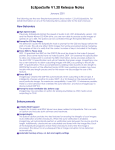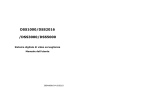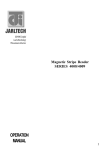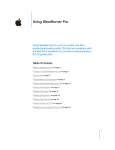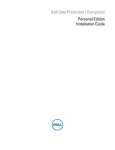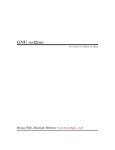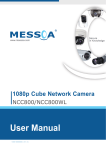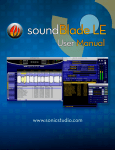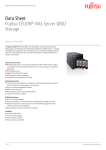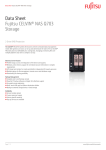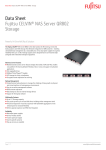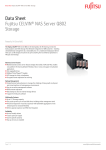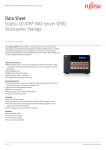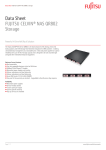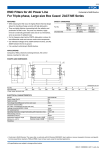Download 1.40 Release Notes - Eclipse Data Technologies
Transcript
EclipseSuite 1.40 Release Notes The following are the new fixes and enhancements since version 1.31 of EclipseSuite. 1.0 Software Installation 1.1 Upgrading to EclipseSuite 1.40 1.2 New Installation 2.0 New Features & Enhancements 2.1 DVD-R Support 2.2 DVD-Audio Support 2.3 DVD-Video Enhancements 2.4 U-Matic Enhancements 2.5 General Enhancements 3.0 Bug Fixes 4.0 New Rules & Exclusions 1.0 Software Installation 1.1 Upgrading to EclipseSuite 1.40 Starting with EclipseSuite 1.40, all Eclipse software requires to be activated on your system dongle. If you are upgrading from a previous version, it is strongly suggested that you do not uninstall any previous version until EclipseSuite 1.40 has been activated and is fully operational. EclipseSuite 1.40 will automatically install itself in a new directory, keeping any existing version of EclipseSuite intact. If you are downloading the software from Eclipse’s FTP site, make sure that you download and read the file “Software Installation.pdf” also located in the same location as the EclipseSuite software. 1.2 New Installation If you are installing the EclipseSuite software for the first time (i.e. no other version of EclipseSuite software exists on your system), then the dongle you received along with the software should already be activated for EclipseSuite 1.40. However, if you are evaluating the software, it may have been activated with limited trial counts. 2.0 New Features & Enhancements 2.1 DVD-R Support EclipseSuite 1.40 includes support for DVD-R General and DVD-R for Authoring media. Although both are DVD-R media, they are not compatible with each other. In fact, each requires a specific DVD-R writer. The EclipseSuite tools include new rules to identify both types of media. 2.1.1 DVD-R General Although DVD-R General media is not designed for mastering purposes, customers use it due to it’s low cost compared to DVD-R for Authoring media. In addition, DVDR General is supported by most DVD-R authoring applications. Unfortunately, DVD-R General does not provide certain information about an image, which is critical in a mastering environment. The most important piece of information that is missing is the image length. DVD-R General does not indicate how much user data is recorded on the disc. The Control data block during Leadin usually provides this information. However, on DVD-R General media, the Control data information always indicates the maximum amount of data that can be recorded on the media, not the actual data that has been recorded. This leaves mastering and pre-mastering systems with only one piece of information to go by. The ISO9660 file system information includes a field, which indicates the amount of data that is recognized by the file system. However, experience has shown that this information is not always correct. DVD-R General also supports a recording method similar to Multisession. When using this method, users can leave the DVD-R General media “appendable” so that additional data can be appended later. This further complicates things for determining the actual amount on data on the media, since most mastering and pre-mastering systems recognize only the first session on a DVD-R General. EclipseSuite 1.40 has been enhanced to support DVD-R General media, including multisession. When ImageCopy is used to transfer a DVD-R General image to tape or hard disk, it automatically makes the necessary changes so that the output image to indicate it is no longer a DVD-R. Two disadvantages of using DVD-R General media targeted for a mastering environment is that it does not support any encryption. In addition, there are many mastering and pre-mastering systems that do not support this format, 2.1.2 DVD-R for Authoring DVD-R for Authoring is the DVD-R format that is designed for mastering purposes since it also supports CSS and CPPM encryption. The Lead-in includes a reserved area in which the image is described. The information in this area describes the copy protection system, if any, as well as the image length. This makes DVD-R for Authoring the preferred media type for a mastering environment. Unfortunately, DVD-R for Authoring requires specific media and DVD-R writers which are different from DVD-R General and are also more expensive. In addition, it is not supported by all authoring systems. There are also many mastering and pre-mastering systems that do not support it. 2.2 DVD-Audio Support The EclipseSuite tools have full support for the new DVD-Audio format. DVD-Audio is a new format that was introduced last year. It is used for the storage of high quality audio music superior to that of a CD-Audio. In order to implement full support for this new format, many rules have been added that check the format of any DVD-Audio image. In addition, the EclipseSuite tools support CMF 1.11 and CMF 1.20, which are used for the representation of DVD-Audio images on tape or hard disk. CMF is similar to DDP in that they both are used to describe images on tape or hard disk. DVD-Audio uses the CPPM copy protection system. The EclipseSuite tools are also capable of verifying that this encryption is applied to an image according to the CPPM specifications. 2.3 DVD-Video Enhancements Check Recording Order Of DVD-Video Files The DVD-Video specifications require that all files be recorded in a specific order. This has been known to cause playability problems. Previous versions of EclipseSuite did not check this. EclipseSuite 1.40 includes new rules that are triggered if files are not recorded in the correct physical order. Ignore Incorrect Filenames On A DVD Tape Image The DDP specifications require that the files on a tape image be recorded in a specific order. The first file on the tape is always DDPID. This file contains records that identify the additional files that make up the image (CONTROL.DAT, MAIN.DAT, etc.). In some cases, the filenames that the DDPID file identifies are different from the actual filenames of the files that are recorded on the tape. In previous versions of EclipseSuite, this would usually result in various errors and/or warnings. In EclipseSuite 1.40, if the filenames do not match, they are ignored and the EclipseSuite tools assume that the files are recorded in the order as described by the DDPID file. Identify Images Requiring Encryption That Are Authored In The Incorrect Storage Mode When a DVD image is stored on tape or hard disk, it can be stored in one of four storage modes. The most common storage mode for an image that does not require encryption is User Data. In this mode, only the user data portion of each sector is stored. When an image requires encryption, it must be stored in at least Complete 2054. In this mode, each sector includes an additional six bytes. Once of these bytes is used by authoring systems to identify the sectors that need to be encrypted. Bugs in authoring systems have caused images requiring encryption to be recorded in User Data mode. In most mastering systems, this would be a fatal error. However, some mastering system may still master the image. This is known to result in playability problems with the replicated discs. EclipseSuite 1.40 has been enhanced to detect this problem. When it detects that an image is recorded in the wrong storage mode, a new rule is triggered alerting the operator. Use The Region Code From MAIN.DAT If CONTROL.DAT Does Not Include A Region Code The region code determines which DVD-Players a DVD-Video will play on. The region code is recorded in the Control Data block during Lead-in and in the Video Manager file in the Main Data. A DVD image on tape or hard disk includes the file CONTROL.DAT that describes the contents of the Control Data block during Lead-in, and the MAIN.DAT file which describes the user data content. The CONTROL.DAT file can be stored in User Data or Complete 2054 storage mode. When the file is stored in Complete 2054 mode, each sector of the file consists of the user data plus six additional bytes. One of the six bytes is used to describe the region code. When the file is stored in User Data mode, the region code is not included. When transferring an image to hard disk, ImageCopy ensures that the output CONTROL.DAT file is always stored in Complete 2054. However, if the original CONTROL.DAT were stored in User Data mode, this would cause ImageCopy to insert a region code of 00h (i.e. All regions), regardless of the region code in the MAIN.DAT file. EclipseSuite 1.40 has been enhanced so that if the source CONTROL.DAT is stored in User Data mode, ImageCopy will generate the output CONTROL.DAT file with the same region code as in the MAIN.DAT. Add New Behavior To Enable/Disabled Padding Of DVD Images The DDP specifications require that the length of the MAIN.DAT file on an image on tape or hard disk be a number that is a multiple of 16. Since the amount of user data in a DVD image may not always generate such a number, authoring systems will pad the MAIN.DAT file to meet this requirement. During mastering, encoder systems use information from the CONTROL.DAT file to determine the correct length of the user data information. In previous version of ImageCopy, when a DVD image was transferred to tape or hard disk, ImageCopy padded the image if the length was not a multiple of 16. When images with padded sectors are mastered using the Eclipse ImageEncoder, it causes the encoder to master including the padding sectors. This causes the length of the replicated discs to be from one up to 15 sectors longer than the original image. This does not cause any playability problems. However, it may cause some confusion if the source image and the replicated discs are verified and an error occurs due to the different lengths. EclipseSuite 1.40 includes the behavior “Do not pad DVD to be a multiple of 16” that allows you to select whether ImageCopy should pad images that don’t meet the DDP specification. If you choose not to pad the image, ImageEncoder does not pad any sectors on the final replica. Identify The Correct Region Code For An Opposite Track Path Layer 1 Image Layer 1 of an Opposite Track Path DVD image on tape or hard disk typically does not include a CONTROL.DAT file. This causes previous versions of EclipseSuite to assume that the Region Code is 00h (All Regions). Although this does not affect the final replicated disc since the correct region code is recorded on Layer 0, it causes some confusion when the incorrect region code is shown in the analysis. EclipseSuite 1.40 now uses the Control Data information from Layer 0 for displaying the correct region code when analyzing Layer 1. However, this information is only available if you analyze Layer 0 first on the same drive. Added New Rules To Detect Invalid Control Data Fields Previous versions of EclipseSuite did not check that the fields in the Control Data information conformed to specifications. For example, the Control Data information on DVD-R media included information that is specific to DVD-R media only. When the image is transferred to tape or hard disk, these fields must be changed to indicate that it is no longer on DVD-R media. EclipseSuite 1.40 has been enhanced to verify that all the Control Data fields comply with the DVD specifications. 2.4 U-Matic Enhancements Added Cue Editor For U-Matic EclipseSuite 1.40 includes a PQ Editor, which allows you to enter or edit index points and timing information for RDAT and U-Matic images. The PQ Editor can be selected in Set DDP Location field of the ImageCopy Media Selection tab. Remove Zero-Length Pause ImageCopy 1.40 removes zero-length pause entries if they are detected in an RDAT or U-Matic image. 2.5 General Enhancements Enhanced Algorithm For Scanning Index Points During the scanning for index points, previous versions of EclipseSuite aborted the index scan if a CRC error, UPC number, ISRC number, or RID/SID information was encountered. If a track had index points higher than index 1, this could result in a track that does not include the same number of index points as the original. EclipseSuite 1.40 has been enhanced to skip any corrupt subcode frames or frames that do not contain an index point, and continue with the index scan. Changed RW Output To DDP 2.00 Specifications If Image Uses DDP 2.00 In previous versions of EclipseSuite, ImageCopy generated RW data files that conformed with DDP 1.00/1.01 specifications. This was regardless if the image used DDP 2.00. Although the DDP 2.00 specifications support this, some encoder systems do not. ImageCopy 1.40 has been enhanced so that when an image is stored using DDP 2.00 and it contains RW data, the RW data files will conform to DDP 2.00 specifications. Enhanced Postgap Behavior To Differentiate Between ROM And Audio Images In previous versions of ImageCopy, the Postgap behavior did not differentiate between Audio and ROM images. If you selected a behavior to adjust the Postgap, ImageCopy would apply the behavior to all images, regardless of the format. Since a Postgap is defined only for CD-ROM images, it does not make sense to add it to an audio image. The Postgap behavior has been enhanced so that by default, it will only append Postgap to CD-ROM images. However, you have an option to specify whether it should also apply it to audio images. Changed Default Severity Of Rule "Invalid Incrementing ATIME In Subchannel" We have increased the severity level of the rule "Invalid incrementing ATIME in subchannel" for CD-DA images as the ATIME error can cause deterioration to the audio quality. Enhanced The Behavior "Do not transfer initial pause of a session" In previous versions of EclipseSuite, this behavior caused the initial pause of a session to be omitted, only if the pause did not contain any user data. This behavior was applied to all images regardless of the format. In EclipseSuite 1.40, this behavior has been split so that you enable or disable it based on the image format. In addition, selecting the behavior forces ImageCopy to omit the initial pause, even if it contains data! The UPC/ISRC/MID Editor Has Been Enhanced To Detect Invalid UPC/EAN and ISRC Numbers In previous versions of EclipseSuite, the UPC/ISRC/MID Editor did not verify the format of ISRC and UPC/EAN numbers. The Editor has been enhanced in EclipseSuite 1.40 to verify that ISRC and UPC/EAN numbers are formatted correctly. Detect Missing Session Bugs in the Plextor 40Max drive sometimes cause the drive not to detect the last session on a multisession CD. EclipseSuite 1.40 has been enhanced to detect when this problem occurs. Enhanced subcode error detection during prescan phase If a subcode error occurred during the prescanning phase, previous versions of EclipseSuite would treat both the subcode and main channel data as corrupt, even if the main channel was unaffected by the error. EclipseSuite 1.40 has been enhanced so that if this condition occurs, the new rule “Subcode error” is triggered and the main channel data is preserved. Changed Eclipse Logo On Printed Logfile To Gray Scale Added a printer friendly logo in the logfile reducing the amount of ink used to print the logo. Support Any DLT8000 and DLT1 Manufacturer EclipseSuite recognizes all models and manufacturers of these devices. Identify MTAO CD-Rs And Enhance Link Block Detection In previous versions of EclipseSuite, an audio CD-R was considered Track At Once if 50% or more of the tracks contained CRC or CU errors at the transition point. If a CD-R was identified as Track At Once, ImageCopy would automatically zero-out the sectors that it considered to be part of the the Link Block. Some CD-R Writers are using a method of recording in which a group of tracks are written in one write operation (Multiple Track At Once). Using the existing Link Block detection algorithm, it is possible that data loss may occur at the transition between this group of tracks. The Link Block detection algorithm has been enhanced so that only transitions which have CRCs or CUs will be zeroed-out. Enhanced ImageCopy To Detect Data Shifts Caused by Subcode Errors Some subcode errors cause the Plextor 40Max drive to drop 24 bytes of data and. When transferring an image to the hard disk, this causes the remaining data to be shifted. EclipseSuite has been enhanced to detect this condition. Detect Subheader Comparison Error In ImageVerify Previous versions of ImageVerify did not compare the Subheader between two images. EclipseSuite 1.40 has been enhanced to do this and reports “Subheader comparison error” if they don’t match. Identifies Mixed-Mode Images EclipseSuite 1.40 includes the rule “Mixed Mode” that is triggered when a Mixed-Mode image is detected. Removes Zero-Length Pause Entries At customers request, EclipseSuite has been enhanced so that ImageCopy removes zero-length pause entries in the DDP files. This had caused problems with encoders that were incompatible with these entries. Enhanced ImageCopy To No Longer Force ISRCs To Index 0 PQ Entries Previous versions of EclipseSuite included a behavior that would force ISRC numbers to the index 0 entries in the DDPPQ file. However, if a track did not include a pause area (i.e. no index 0), ImageCopy would generate a zero-length PQ entry in order to record the ISRC number. This zero-length entry caused problems on some encoder systems. This behavior has been removed in EclipseSuite 1.40. Compare Map Stream Length In DDPMS To Lead-out Start In DDPPQ EclipseSuite previously had difficulty if the DDPMS file indicated that Leadout started earlier or later than the location indicated in the DDPPQ file. When the image was transferred with ImageCopy, this resulted in an image that was longer or shorter than the source. EclipseSuite 1.40 includes a new rule warning you of possible data loss. 3.0 Bug Fixes Fixed Command Sequence Error For Pioneers 305 Non-CSS DVD-Video discs. With the introduction of the DVD-ROM 305 drive, Pioneer changed one of the commands that is issued to the drive. This caused the authentication process between the drive and EclipseSuite tools to fail on DVD-Video discs that did not contain CSS encryption. This condition has been corrected in EclipseSuite 1.40. Force the Yamaha 2100S writer to flush its memory buffers. Data was being left in memory causing an unrecorded area on the disc. The Yamaha 2100S CD-R Writer requires that its buffers be flushed at the end of a recording operation. Previous versions of ImageCopy did not flush the buffers, which caused data loss and abort of the copy operation. DDPMS section was not saved correctly in the log file when the split file option was selected. This caused the AudioViewer to shift index locations and truncate the last track during playback. When the Split File Output Behavior was used in previous versions of EclipseSuite, the DDPMS section was not written properly when saving the information to a logfile. If AudioViewer data was saved to the logfile and the user attempted to display this information with the AudioViewer, it would cause the AudioViewer display to shift the index locations and the last track appeared to be truncated. Fixed problem where Jacket Picture files with an Mpeg_end_code would cause the EclipseSuite tools to treat it as an invalid pack end code. Corrected problem where the image path would not be saved in a logfile. Previous versions of EclipseSuite did not save the image path to a logfile. If the logfile was re-loaded at a later time, the Media Selection tab would not have the original path to the image. This would cause errors if the user tried to access the Main Channel and Subchannel Viewers. Fixed PQ Descriptor file name problem in ICheck utility on images from tape or hard disk . Previous versions of the ICheck utility expected that the PQ Descriptor file be named “DDPPQ”. Some systems generate a PQ Descriptor file with a different name. This caused the ICheck utility to fail since it was expecting the file DDPPQ and could not find it. Corrected an ImageCopy audio comparison errors during Verify After Copy operation. When copying a consolidated audio image (i.e. from tape or hard disk) using the Split File output behavior, it would cause audio comparison errors during the Verify After Copy operation. Fixed a problem which caused the Verify After Copy behavior to be shown selected everytime the user displayed the General behaviors. Fixed a problem where the ImageVerify print options were not being initialized properly. When the user sets the print options in any of the EclipseSuite tools, the settings are saved in the registry so that the next time the user chooses to print a logfile, the same optinos will be selected. In the previous verison of EclipseSuite, ImageVerify always set the print options to the original default setting. Corrected a problem where comparison errors where shown when ImageVerify faild to sync the source and target audio images for comparison. If ImageVerify failed to sync two audio tracks for comparison, previous versions of ImageVerify would trigger the rule “Comparison error”. This has been changed so that in version 1.40, the error “Failed to sync audio for comparison” is triggered instead. Fixed a problem where the rule "ISRC detected in ROM track" was not being triggered. In previous versions of EclipseSuite, the rule “ISRC detected in ROM track” would never be triggered. This caused a problem when RW data was included in the ROM track of a Mixed Mode CD. Removed the rule “24 byte substitution”. This rule has been removed since it was masking audio comparison errors. Instead of triggering this rule, a comparison error will be triggered when this condition occurs. 4.0 New Rules & Exclusions In order to support some of the new features and enhancements, Eclipse has added a new set of rules and exclusions in EclipseSuite 1.40. For detailed information on any of the rules, please refer to the EclipseSuite User’s Manual. Audio coding mode incompatible with TV system Audio Manager files not in correct physical order Audio Manager IFO and BUP files in same ECC block Audio Still Video file not 4KB in size Audio Still Video files not in correct physical order Audio Still Video IFO and BUP files in same ECC block Audio Title Set IFO and BUP files in same ECC block Audio zone files located after Video zone files C2 point detected Cleared CP_SEC on unencryptable sector Cleared PES_scrambling_control on unencryptable sector CMF level 1.10 CMF level 1.11 CMF level 1.20 Comparison error - no MKB Control data & CMF CPPM version disagree Control data & DDP CPS_TY disagree Control data & CMF layer 0 end disagree Control data & CMF layer 0 start disagree Control data & CMF layer 1 end disagree Control data & CMF layer 1 start disagree Control data & CMF Prerecorded Media Type disagree Control data CPR_MAI disagree (sector 2 to 15) Control data CPS_TY & ISO9660 protection state disagree Control data PM_TY & ISO9660 disagree CP_MOD invalid on CPPM scrambled sector CP_MOD invalid on non-CPPM-scrambled sector CPPM descramble of sector failed CPPM keys could not be found CMF & ISO9660 Media Key Block layer disagree CMF & ISO9660 Media Key Block location disagree DDPMS leadout start greater than PQ DVD-Audio file is tagged for CSS DVD-Audio file size greater than 1 GB in size DVD-Audio with CPPM using DDP 2.0/2.1 DVD-Audio Zone files not in correct physical order DVD-Audio Zone missing essential file DVD-Audio DVD-R general DVD-R DVD-RW DVD-Video file is tagged for CPPM DVD-Video file is tagged for CPRM Error when loading CPPM keys - not transferred Error when writing CPPM keys - not transferred No File tagged for CPPM No File tagged for CSS and CPPM No File tagged for CSS Illegal use of CP_MOD field Input stream missing 24 bytes data Invalid control data book type Invalid control data book version Invalid control data disc size Invalid control data layer type Invalid control data linear density Invalid control data maximum transfer rate Invalid control data number of layers Invalid control data track density Invalid control data track path Invalid CP_MOD value for CPPM Invalid CP_MOD value for CSS Invalid CPS_TY Invalid DVD-Audio CPPM version Invalid layer break location Invalid PES scrambling value for CPPM Invalid PES scrambling value for CSS Invalid PM_TY Invalid sector size for CSS Maximum program area exceeded Media Key Block comparison error Mixed Mode CD More than one Forced Caption with same Language Code detected Non-zero CPM or CP_SEC or CGMS field found in non-CSS/CPPM/CPRM file Number of audio channels incompatible with audio coding mode Number of Audio Title Sets Overrode CP_SEC to match PES_scrambling_control on encryptable sector Overrode PES_scrambling_control to match CP_SEC on encryptable sector Pause data not copied PES scrambling value reserved for CPRM PES_Scrambling_Control not set for encrypted VTS Region code not zero for hybrid DVD-Audio & DVD-Video image ROM Subheader comparison error Simple Audio Manager file not 128KB in size MKB location field has been converted from LBA to physical address Title Set files not in correct physical order TOC missing last session TV system incompatible with region limits Unable to read subcode Video Manager IFO and BUP files in same ECC block Zero Video Title Set












